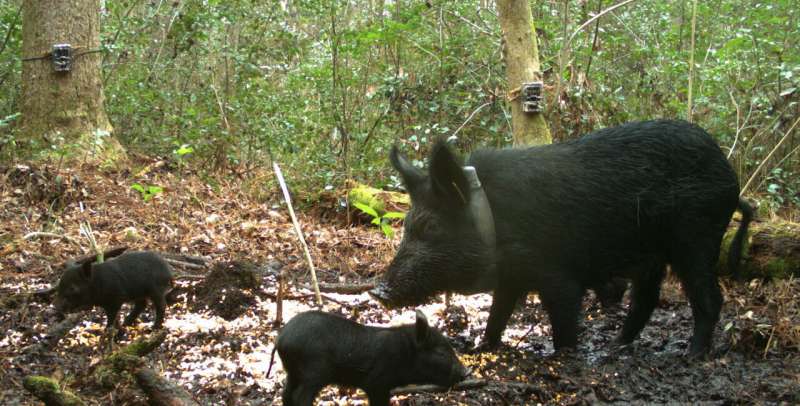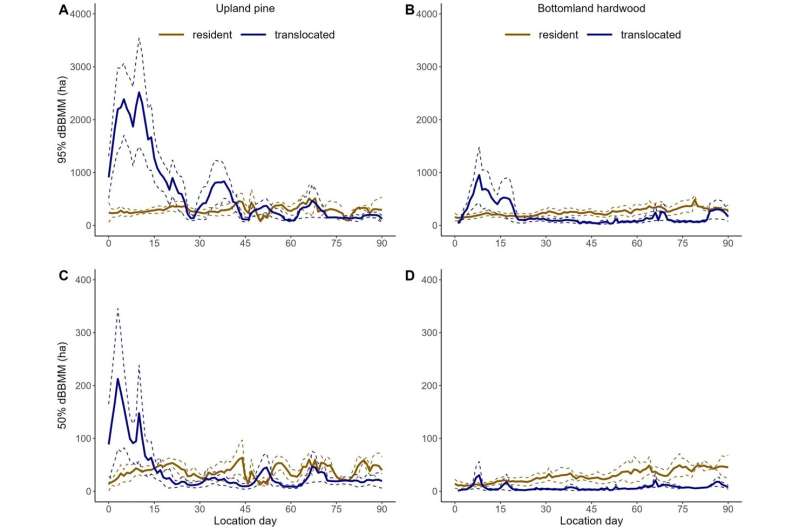This article has been reviewed according to Science X's editorial process and policies. Editors have highlighted the following attributes while ensuring the content's credibility:
fact-checked
peer-reviewed publication
trusted source
proofread
Study offers insights into movement of wild pigs

Recent research highlights the potential for problems when pigs are relocated, often illegally for hunting
When introduced into a new area, wild pigs will roam. A lot.
That's one finding from a new study by researchers at the University of Georgia who followed the movements of relocated wild pigs—also referred to as feral hogs—over several months. Infamous for the damage they cause to crops and landscapes, the research highlights the potential for problems when pigs are relocated—often illegally for hunting—and the potential risks of them spreading diseases such as African swine fever when they are moved around the landscape.
The research was published in the journal Scientific Reports and is the first to examine movement among wild pigs relocated to new areas. While most states have laws that prohibit relocating invasive species, such as pigs, the practice still happens, and is one of the main factors contributing to the recent explosion in pig numbers across the United States.
"That's why we did the study. All these pigs are being moved around and we really have no idea what's happening with them," said James Beasley, the Terrell Professor of Forestry and Natural Resources at the UGA Warnell School of Forestry and Natural Resources and senior author of the study.
"We looked at whether they stayed near their release locations over time and how their home ranges and movements differed from individuals that were not relocated. This type of information is critical to developing management plans for responding to new introductions of pig populations."
The study was conducted at the Savannah River Site outside Aiken, South Carolina. Because the property spans more than 310 square miles, Beasley said the researchers could move pigs to new locations within the property and still feel confident they were in an unfamiliar place. South Carolina law prohibits moving wild pigs unless they remain on the same property.
After capturing a pig and fitting it with a GPS collar, the researchers moved it to another location, typically at least 10 miles away, and tracked their movements over several months.

The trackers showed the pigs were able to cover a lot of ground in a small time frame. Over a seven-day period, on average, the wild pigs would make sweeping paths across the landscape, rarely returning to their initial drop-off point and often eventually ending up several miles away.
"What we saw with the pigs—nearly all of them—was their initial movements seemed to be more one-directional, like a straight line, as if they were trying to find home," said Beasley. "Then they would loop back, as if they didn't find what they were looking for and came back to a familiar place. Almost like spokes on a wheel. A few of the pigs even were able to find their original territories."
The pigs proved to be very social
And, these new pigs didn't roam alone. The researchers also found that not long after being released, the wild pigs hooked up with other pigs in the area—sometimes joining an existing social group of pigs and other times creating new groups of relocated individuals.
In one instance, said Beasley, two pigs from the same group were released more than a mile apart. "They started moving in different directions. Then, one seemed to cross the path of the other one and found that pig," he said. "They have this really incredible social bond and social structure."
Moving wild animals isn't uncommon for conservation purposes. For example, elk and bighorn sheep have been relocated to reestablish those species across their native range. But studies on animals after these types of relocations tend to focus more on survival or coarse-scale movements rather than fine-scale movements that illuminate how animals form home ranges in new areas, said Beasley. Although, in general, when animals are brought to a new area, they tend to conserve their energy and movements until establishing a steady food source.
Wild pigs, on the other hand, seemed intent on searching for their social group. When they didn't encounter a familiar place, they would inevitably connect with another pig and settle into a new home range, which typically took two to four weeks. More study is needed to understand how these social bonds form, said Beasley, but it's clear that wild pigs are willing to accept unrelated individuals within their social group.
"Pigs are incredibly social animals," added Beasley. "Within one to two months, almost all the pigs had found other groups and assimilated within those groups, which I thought was very interesting given that most pig social groups are comprised of close relatives."
More information: Joshua B. Smith et al, Habitat quality influences trade-offs in animal movement along the exploration–exploitation continuum, Scientific Reports (2023). DOI: 10.1038/s41598-023-31457-3
Journal information: Scientific Reports
Provided by University of Georgia



















